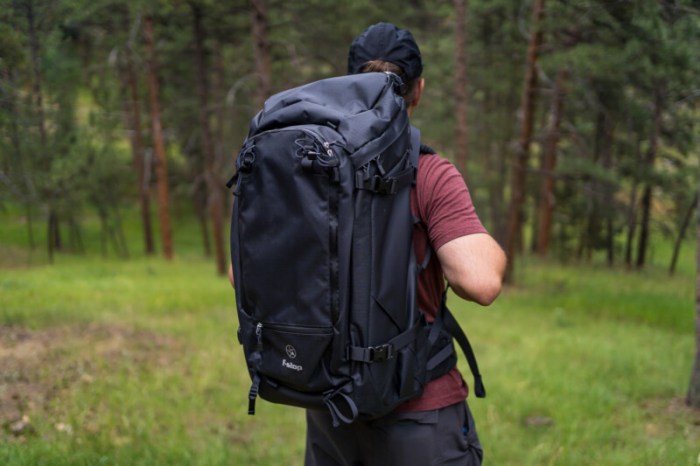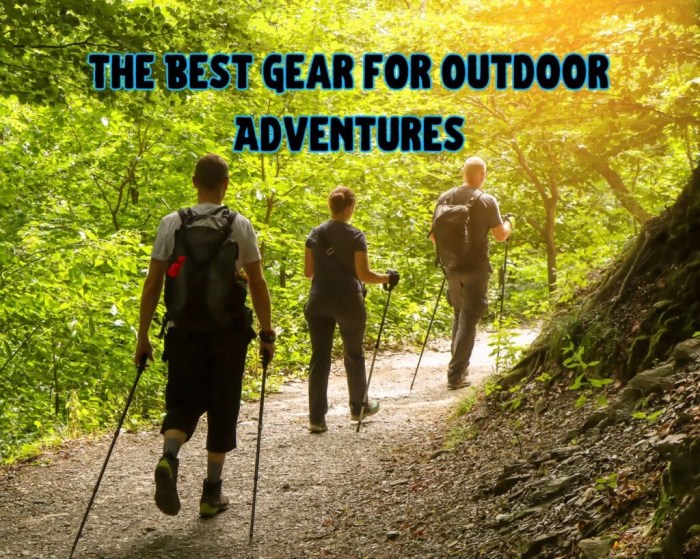Backpacks & Bags for Outdoor Adventures
Choosing the right backpack is crucial for any outdoor adventure. The ideal pack will depend on the activity, duration, and the amount of gear you need to carry. Consider factors like capacity, weight, comfort, and durability when making your selection.
Essential Features of High-Quality Backpacks
High-quality backpacks for various outdoor activities share several key features. Hiking backpacks prioritize comfort and ventilation, often featuring adjustable torso lengths and breathable mesh back panels. Camping backpacks typically offer larger capacities and multiple compartments for organizing gear. Climbing backpacks are designed for secure gear carrying and often integrate climbing-specific features like ice axe loops and helmet holders. All three types benefit from durable, water-resistant materials and robust construction.
Comparison of Backpack Styles
Backpack styles vary significantly. Internal frame backpacks distribute weight more evenly across the back, providing better comfort for heavier loads. External frame backpacks offer better ventilation but can be less comfortable for long hikes. Top-loading backpacks are simpler, while panel-loading backpacks allow easier access to gear. The choice depends on personal preference and the type of adventure.
Durable, Water-Resistant Backpack Materials
Durable and water-resistant materials are essential for protecting your gear. Nylon and polyester are common choices, offering varying degrees of water resistance and tear strength. Ripstop nylon is particularly robust, while coated fabrics provide additional waterproofing. Many high-end backpacks incorporate these materials in combination for optimal protection.
Comparison of Popular Backpack Brands
| Brand | Key Features | Price Point | Best Use |
|---|---|---|---|
| Osprey | Durable materials, comfortable fit, lifetime warranty | $$$ | Hiking, backpacking, camping |
| Gregory | Excellent suspension systems, various sizes and styles | $$$ | Hiking, backpacking |
| Deuter | Innovative designs, focus on ergonomics, high quality | $$$ | Hiking, trekking, mountaineering |
Navigation & Communication Tools
Reliable navigation and communication are paramount for safe outdoor adventures. Choosing the right tools depends on the remoteness of the area and the complexity of the terrain. Understanding the strengths and limitations of each technology is key to making informed decisions.
Map and Compass vs. GPS Devices
Maps and compasses offer a reliable backup navigation system, independent of batteries or technology. They require skill and knowledge to use effectively. GPS devices offer precise location data and route planning capabilities but rely on batteries and satellite signals, which can be unreliable in certain areas. A combination of both is ideal for redundancy.
Satellite Messenger Devices
Satellite messenger devices provide reliable communication in areas without cellular service. They transmit messages via satellite, allowing you to contact emergency services or loved ones even in remote locations. Features like GPS tracking and pre-programmed emergency messages enhance safety. Examples include Garmin inReach and SPOT devices.
Maintaining Electronic Navigation Devices
Proper care ensures the longevity of electronic navigation devices. Protect them from moisture and impacts, and keep batteries charged. Regularly check for software updates and ensure the device is properly calibrated. Consider carrying spare batteries and a backup navigation system.
Essential Apps for Outdoor Navigation and Communication
- Gaia GPS: Detailed maps, route planning, offline functionality.
- AllTrails: Trail information, reviews, and user-submitted photos.
- Avenza Maps: Customizable maps, offline capability, GPS tracking.
- Zello: Walkie-talkie functionality for group communication.
Clothing & Footwear for All Conditions
Appropriate clothing and footwear are crucial for comfort, safety, and performance during outdoor adventures. Adapting to changing weather conditions is essential to prevent hypothermia and other weather-related issues. Selecting the right gear for different terrains and activities is also important.
Layering Clothing for Temperature Regulation
Layering clothing allows you to adjust your insulation based on activity level and environmental conditions. A base layer wicks moisture, a mid-layer provides insulation, and an outer layer protects from wind and rain. This system allows for flexibility in managing body temperature.
Benefits of Moisture-Wicking Fabrics
Moisture-wicking fabrics, such as merino wool and synthetic materials, draw sweat away from the skin, preventing it from chilling you. This is crucial for preventing hypothermia, especially in cold and wet conditions. These fabrics also help to regulate body temperature and keep you comfortable.
Suitable Footwear for Different Terrains
Hiking boots provide ankle support and protection for rugged terrain. Trail runners offer lighter weight and better agility for less technical trails. Water shoes are ideal for wet and rocky areas. The best choice depends on the specific terrain and activity.
Comparison of Outdoor Jackets
| Jacket Type | Pros | Cons | Best Use |
|---|---|---|---|
| Waterproof | Protection from rain and snow | Can be less breathable | Rainy or snowy conditions |
| Windproof | Protection from wind chill | May not be waterproof | Windy conditions |
| Insulated | Provides warmth in cold conditions | Can be bulky and less breathable | Cold weather activities |
Illumination & Safety Equipment
Adequate illumination and comprehensive safety equipment are essential for any outdoor adventure. Proper lighting ensures visibility and safety during night activities, while a well-stocked first-aid kit is crucial for addressing injuries. Additional safety devices such as whistles and personal locator beacons can significantly enhance safety in emergency situations.
Headlamps and Flashlights
Headlamps offer hands-free illumination, while flashlights provide more focused beams. Consider factors like brightness (lumens), battery life, and features like red light modes (for preserving night vision) when choosing. Having both a headlamp and flashlight provides versatility.
First-Aid Kit Contents
A comprehensive first-aid kit should include supplies for treating minor injuries, such as cuts, scrapes, and blisters, as well as more serious injuries like sprains and fractures. Essential items include bandages, antiseptic wipes, pain relievers, and any personal medications.
Importance of Whistles and Personal Locator Beacons (PLBs)

A whistle can be used to signal for help over long distances, while a PLB transmits a distress signal to emergency services via satellite, providing location information even in remote areas. Both are vital safety devices for any outdoor adventure.
Visual Representation of a Well-Stocked First-Aid Kit
The kit should be organized and easily accessible. Imagine a sturdy, waterproof case containing compartments for bandages (various sizes), antiseptic wipes, pain relievers (ibuprofen, acetaminophen), blister treatment, antibiotic ointment, tweezers, small scissors, gauze pads, medical tape, and a detailed first-aid instruction booklet. Personal medications should also be included.
Cooking & Hydration Essentials
Efficient cooking and hydration systems are vital for multi-day outdoor adventures. Choosing lightweight and efficient equipment is crucial, as is understanding safe water purification methods. Careful meal planning ensures adequate nutrition and minimizes weight.
Portable Cooking Systems
Portable stoves fueled by canister fuel or alcohol are common choices for backpacking and camping. Consider factors such as fuel efficiency, weight, and ease of use when selecting a stove. Lightweight cookware is also important to minimize pack weight.
Water Filtration and Purification, Best accessories for outdoor adventure gear
Water filters remove sediment, bacteria, and protozoa, while purification tablets kill harmful microorganisms. Both methods are effective for making water safe to drink. The choice depends on personal preference and the quality of the water source.
Efficient Food Storage and Meal Planning
Proper food storage prevents spoilage and attracts animals. Use airtight containers and bear canisters where necessary. Plan meals that are lightweight, nutritious, and easy to prepare. Consider calorie needs and the duration of the trip.
Lightweight and Nutritious Food Options

- Dried fruits and vegetables
- Energy bars and gels
- Instant oatmeal and rice
- Dehydrated meals
- Nuts and seeds
Sun Protection & Insect Repellent
Protecting yourself from the sun and insects is crucial for a comfortable and safe outdoor experience. Appropriate sun protection prevents sunburn and long-term skin damage, while insect repellent minimizes bites and the risk of insect-borne diseases.
Importance of Sunscreen and Protective Clothing
Using a broad-spectrum sunscreen with a high SPF (30 or higher) and wearing protective clothing, such as long sleeves and a hat, is essential to prevent sunburn. Reapply sunscreen frequently, especially after sweating or swimming.
Effectiveness of Insect Repellents
Insect repellents containing DEET, picaridin, or IR3535 are effective at repelling mosquitoes, ticks, and other biting insects. Follow the instructions on the product label for safe and effective application.
Sun Hats and Sunglasses
A wide-brimmed hat provides shade for the face and neck, while sunglasses protect eyes from harmful UV rays. Choose hats and sunglasses that are comfortable, durable, and offer adequate protection.
Ingredients in High-Quality Insect Repellent
High-quality insect repellents often contain DEET (N,N-diethyl-meta-toluamide) as the active ingredient. DEET works by interfering with the insect’s sensory system, making it difficult for them to locate and bite humans. Other effective ingredients include picaridin and IR3535.
Ultimate Conclusion: Best Accessories For Outdoor Adventure Gear
Best accessories for outdoor adventure gear – Ultimately, the best accessories for your outdoor adventure gear depend on the specific activity, location, and duration of your trip. By carefully considering the factors discussed—from reliable navigation and communication tools to appropriate clothing and safety equipment—you can significantly enhance your chances of a safe, comfortable, and unforgettable experience. Remember to prioritize quality, durability, and functionality when making your selections. Happy adventuring!
